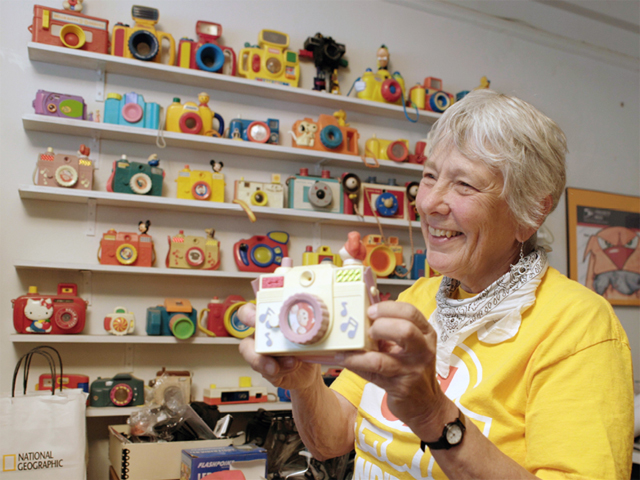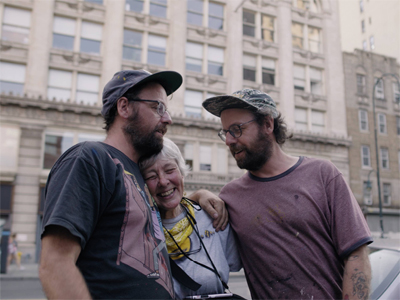Selina Miles Martha: A Picture Story Interview

Martha: A Picture Story
Director: Selina Miles
Genre: Documentary
Running Time: 82 minutes
Synopsis: Martha Cooper is an unexpected icon of the street art movement - a tiny, grey-haired figure running alongside crews of masked graffiti artists.
In the 1970's, as the boroughs of New York City burned, she worked as a photographer for the New York Post, seeking images of creativity and play where others saw crime and poverty. As a result, she captured some of the first images of New York graffiti, at a time when the city had declared war on this new culture. Martha and her co-author Henry Chalfant compiled these images into the book Subway Art. However, the commercial failure of the book forced Martha to leave graffiti behind, moving on to document many other hidden cultures of New York.
20 years later Martha discovers she has become a legend of the graffiti world - a culture that has now exploded into a global movement. Subway Art became one of the most sold - and stolen - art books of all time, photocopied and shared by graffiti artists for decades.
At 75 years of age, Martha finds herself navigating a culture vastly changed. The small community born from struggle and adversity, has grown into a commercial industry fuelled by the rise of social media. Now every new piece of street art is immediately uploaded, and crowds line up for selfies in front of popular works. Martha struggles to find her place in this new world, driven by a passion for capturing the creativity that helps people rise above their environment.
Martha: A Picture Story
Release Date: November 28

Interview with Selina Miles
Question: Can you tell us about Martha: A Picture Story?
Selina Miles: Martha Cooper is an unexpected icon of the street art movement - a tiny, grey-haired figure running alongside crews of masked graffiti artists.
In the 1970's, as the boroughs of New York City burned, she worked as a photographer for the New York Post, seeking images of creativity and play where others saw crime and poverty. As a result, she captured some of the first images of New York graffiti, at a time when the city had declared war on this new culture. Martha and her co-author Henry Chalfant compiled these images into the book Subway Art. However, the commercial failure of the book forced Martha to leave graffiti behind, moving on to document many other hidden cultures of New York.
20 years later Martha discovers she has become a legend of the graffiti world " a culture that has now exploded into a global movement. Subway Art became one of the most sold " and stolen " art books of all time, photocopied and shared by graffiti artists for decades.
At 75 years of age, Martha finds herself navigating a culture vastly changed. The small community born from struggle and adversity, has grown into a commercial industry fuelled by the rise of social media. Now every new piece of street art is immediately uploaded, and crowds line up for selfies in front of popular works. Martha struggles to find her place in this new world, driven by a passion for capturing the creativity that helps people rise above their environment.
Question: How did the project of Martha: A Picture Story come about?
Selina Miles: I have been documenting street art and graffiti for 10 years, and in 2013 I met Martha Cooper at a street art festival in Tahiti. I knew of her iconic book Subway Art before meeting her, but had little knowledge of the rest of her amazing catalogue. We worked side by side both in this festival and in the following year, at which time I proposed a 10 minute video profile, to which she agreed. It wasn't until I arrived in New York to start filming that I really understood the amazing depth and potential of her incredible story, and the project rapidly evolved from a short to a feature film.
Question: What was the best part about making this film?
Selina Miles: The best part about making this film was getting to observe and learn from Martha Cooper. She really is an exceptional talent and a force of nature. To be working internationally and with such a relentless level of passion and persistence at her age is something I think we can all aspire to. It was also an amazing opportunity to really interact with and understand analog photography in a way that I hadn't previously. Much of Martha's catalogue was shot on Kodakchrome slide film, and much of her personal archive was Super 8, and hadn't been seen since the 1980s. Rifling through those treasures was definitely a highlight.
Question: What do you hope audiences take away from Martha: A Picture Story?
Selina Miles: I hope that audiences find joy and inspiration in Martha's story. I think at its core it's a story about perseverance, and about finding and following your true voice, regardless of what others think. I think that if you find your true passion and work persist with it, it will always pay off, one day - maybe in 40 years! And finally, for those who haven't previously understood or appreciated graffiti, I hope that it offers a fresh perspective on the subculture.
Question: Can you share Martha's thoughts on the film, with us?
Selina Miles: Martha can be extremely tough when it comes to the presentation and the publishing of her photos, but when it came to the film, I was very grateful that she gave me total trust and respect editorially. She didn't see a cut of the film until it was completed, and I flew to New York to screen it to her and a small group that included many of the contributors to the story. That was definitely a nerve-racking moment for me. Fortunately, there was unanimous approval for the film, a few tears, and the best part - a lovely dinner afterward full of excited discussion and debate around some of the themes, which is all that I think I could ever hope for.
Interview by Brooke Hunter
MORE



